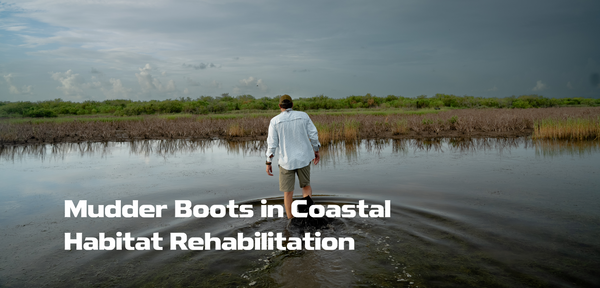
Mudder Boots in Coastal Habitat Rehabilitation
Coastal habitat rehabilitation often involves labor-intensive fieldwork in some of the Earth’s most unstable environments. Areas like salt marshes, tidal flats, and wetlands are vital for biodiversity, but their soft, waterlogged soils create unique challenges for rehabilitation workers.
Sinking into Soft Sediments
Mudflats and marshes consist of fine, water-saturated silt or clay. The lack of support can cause workers to sink knee-deep or even farther, costing excessive energy and time to free themselves. This slows down progress and limits the vital time available for critical tasks like planting vegetation or removing invasive species.
Boot Damage from Debris
Sharp oyster shells, rocks, and human-made pollutants are abundant in coastal zones. Traditional boots or waders can get punctured or wear down quickly, increasing the need for multiple replacements and raising project costs.
Safety Risks
Slipping and sinking are the biggest challenges in unstable terrain like coastal mud. Along with injuries, exposure to cold and wet conditions can also lead to fatigue or hypothermia.
Environmental Impact
Excessive foot traffic compacts soil, crushes delicate plant roots, and further disturbs habitats for small organisms like crabs and insects. Such unintentional damage undermines rehabilitation efforts by destabilizing the ecosystem.

Traditional footwear fails in these conditions because it concentrates body weight onto a small surface area, creating pressure that causes boots to sink. Mudder Boots solve this problem by mimicking the principle of snowshoes: redistributing weight across a wider area to reduce ground pressure. This keeps workers agile, upright, and minimizes their ecological footprint.
How Mudder Boots Work?
Mudder Boots are not ordinary footwear—they are designed as an upgrade to existing boots or waders. Their innovative features directly address the harsh realities of coastal work:
1. Expandable Wings for Stability
The boots feature expandable wings that remain closed on firm ground. When stepping onto soft surfaces (e.g., mud), the wings automatically fan outward, creating 225 square inches of support per boot—four times the surface area of a standard boot.
As the foot lifts, the wings fold back to their original 8-inch width, allowing natural movement on solid terrain. This dynamic design prevents sinking while reducing fatigue, enabling workers to cover more ground efficiently and move freely.
2. Built for Coastal Conditions
Steel buckles are coated with black oxide, a corrosion-resistant finish that withstands saltwater exposure (with proper rinsing after use). It repels sticky mud, oil residues, and pollutants, simplifying cleanup and maintaining traction.
Small perforations between treads break vacuum-like suction forces in thick mud, making it easier to lift each foot. The holes also allow water and silt to drain, reducing weight buildup.
3. Eco-Conscious Durability
Constructed from recycled polyurethane, a durable plastic that diverts waste from landfills. Moreover, its rigid, high-quality construction ensures the boots withstand abrasion, UV exposure, and repeated use across multiple seasons. This reduces the need for replacements, aligning with sustainable project budgets.
4. Versatility for Diverse Teams
Adjustable straps accommodate men’s shoe sizes 5–13, making them suitable for teams with varied foot sizes. Weighing just a few pounds per pair, they’re easy to carry to remote sites and quick to strap on over waders or hiking boots.
Why This Matters for Coastal Rehabilitation?
By addressing the physical and environmental challenges of muddy fieldwork, Mudder Boots empower conservationists to:
-
Preserve Energy: Spend less time battling terrain and more time restoring habitats.
-
Protect Ecosystems: Minimize soil compaction and root damage, giving rehabilitated plants and animals a better chance to thrive.
-
Reduce Costs: Durable materials and design lower long-term equipment expenses.
For teams committed to rebuilding coastlines, Mudder Boots aren’t just a tool—they’re a force multiplier, turning treacherous mudflats into manageable workspaces.




